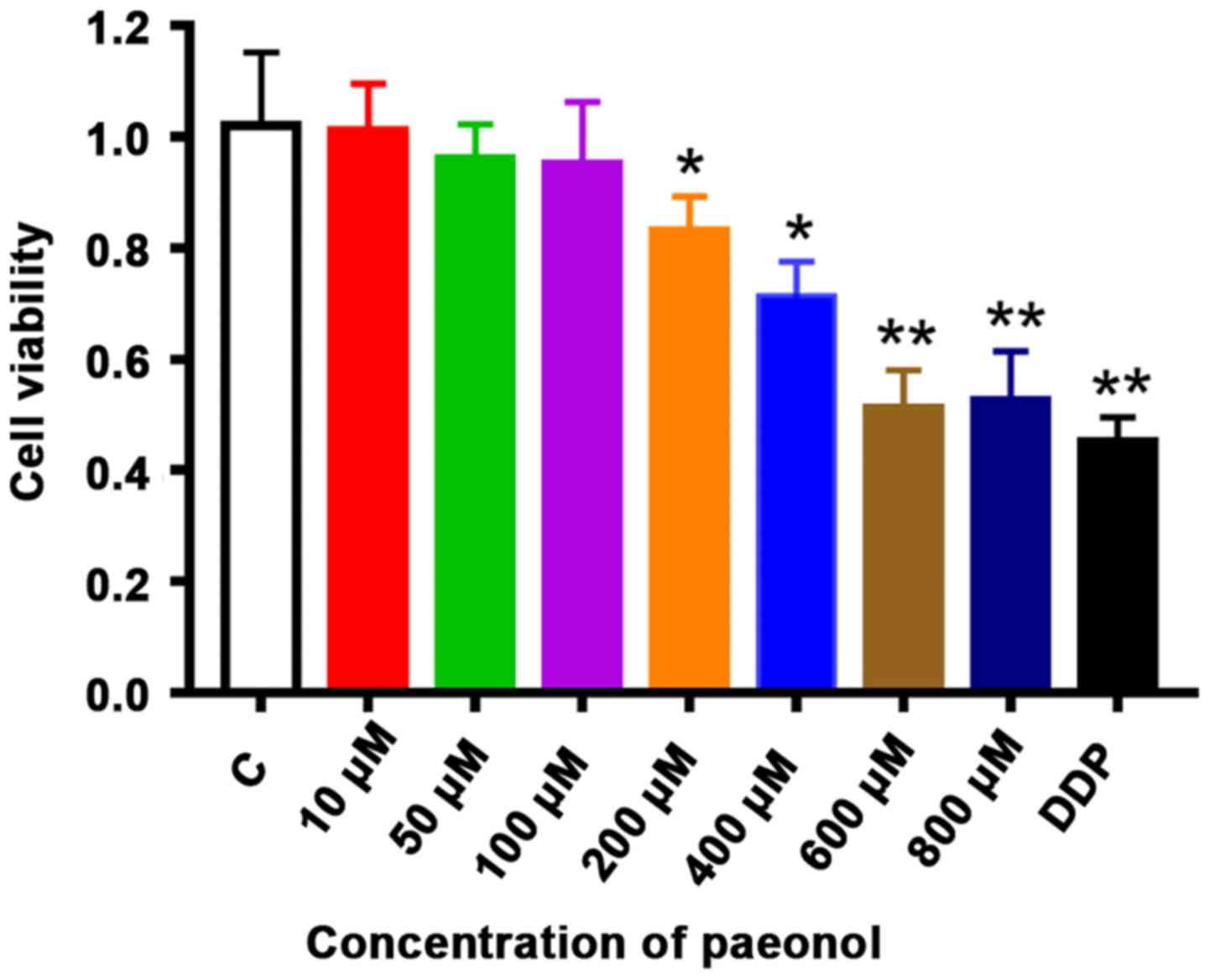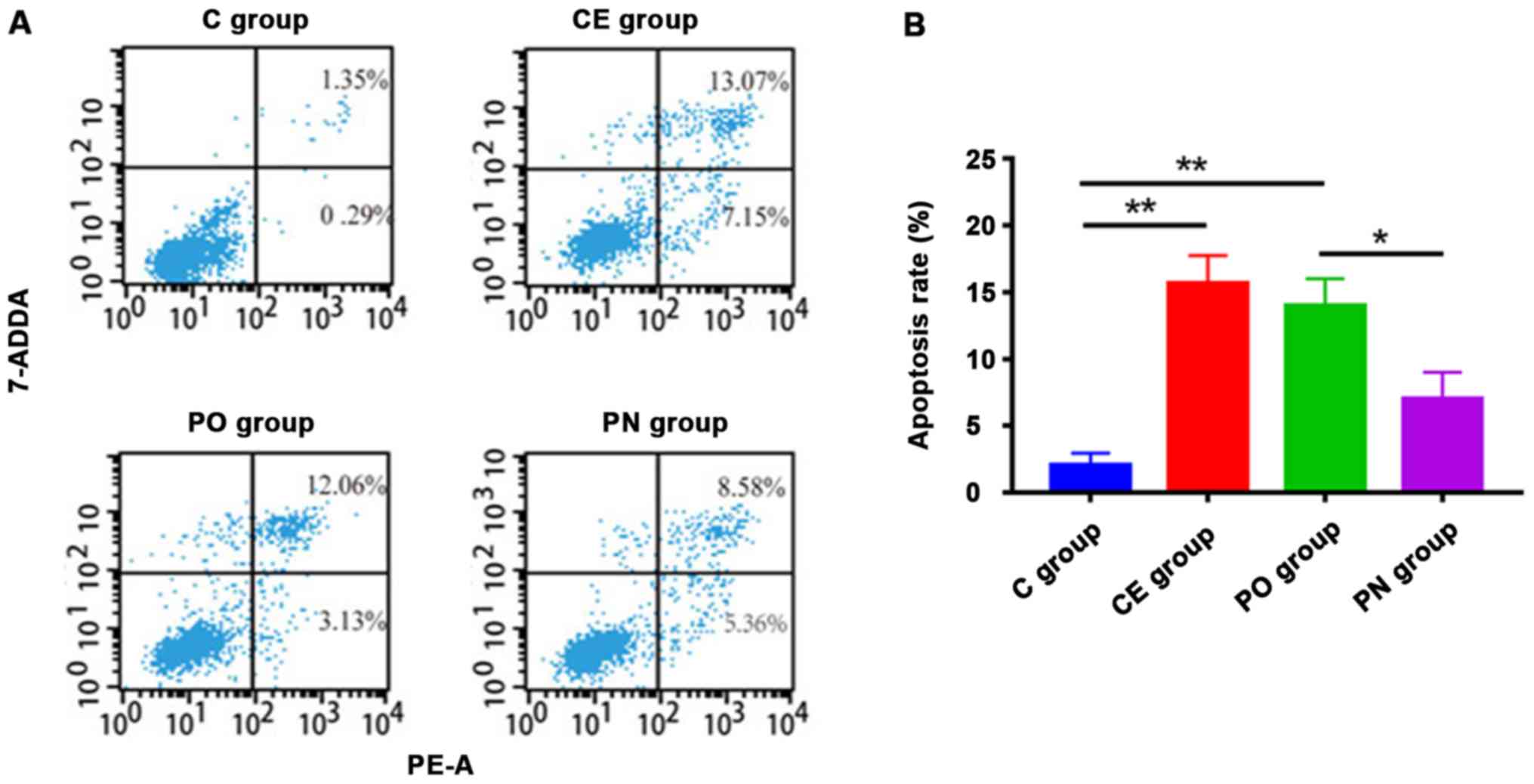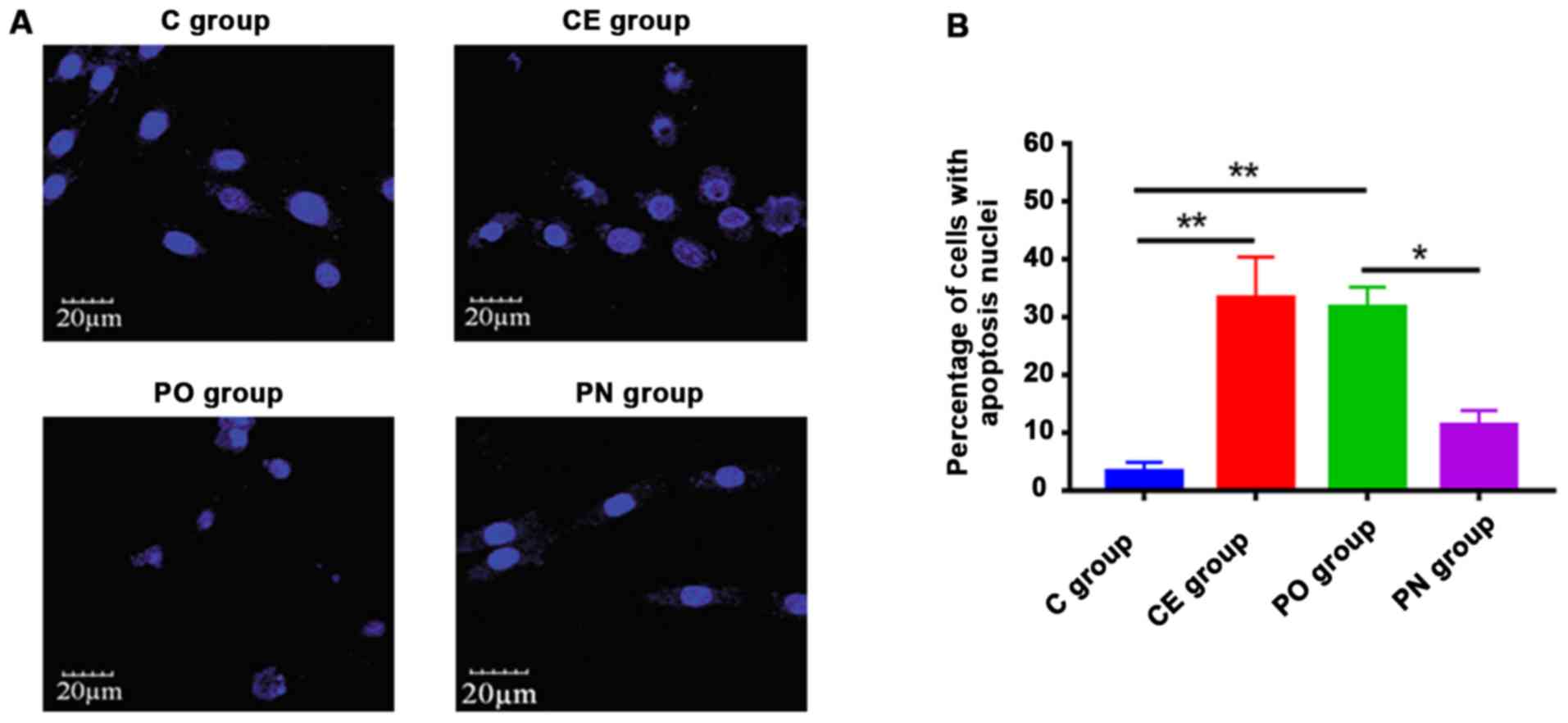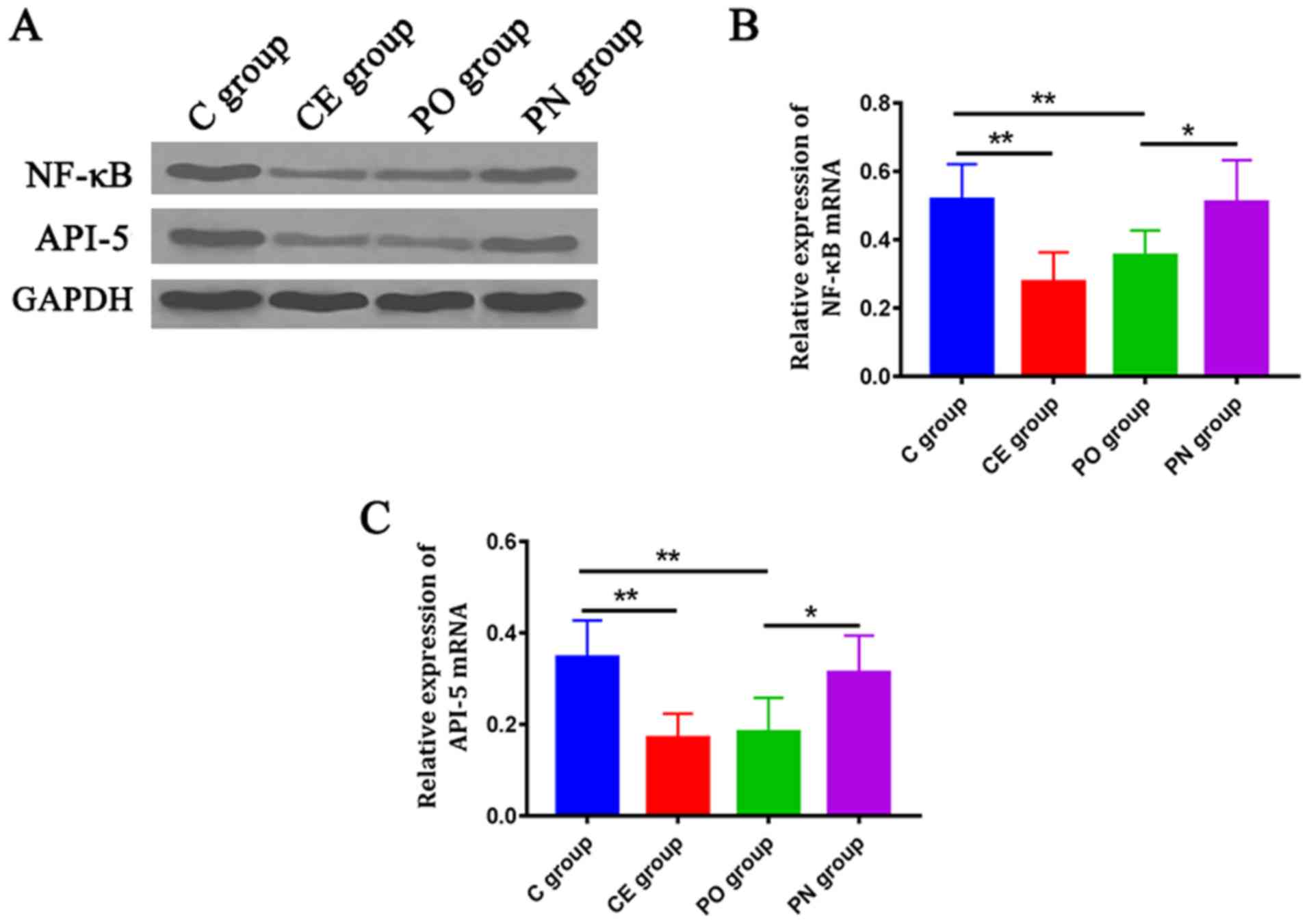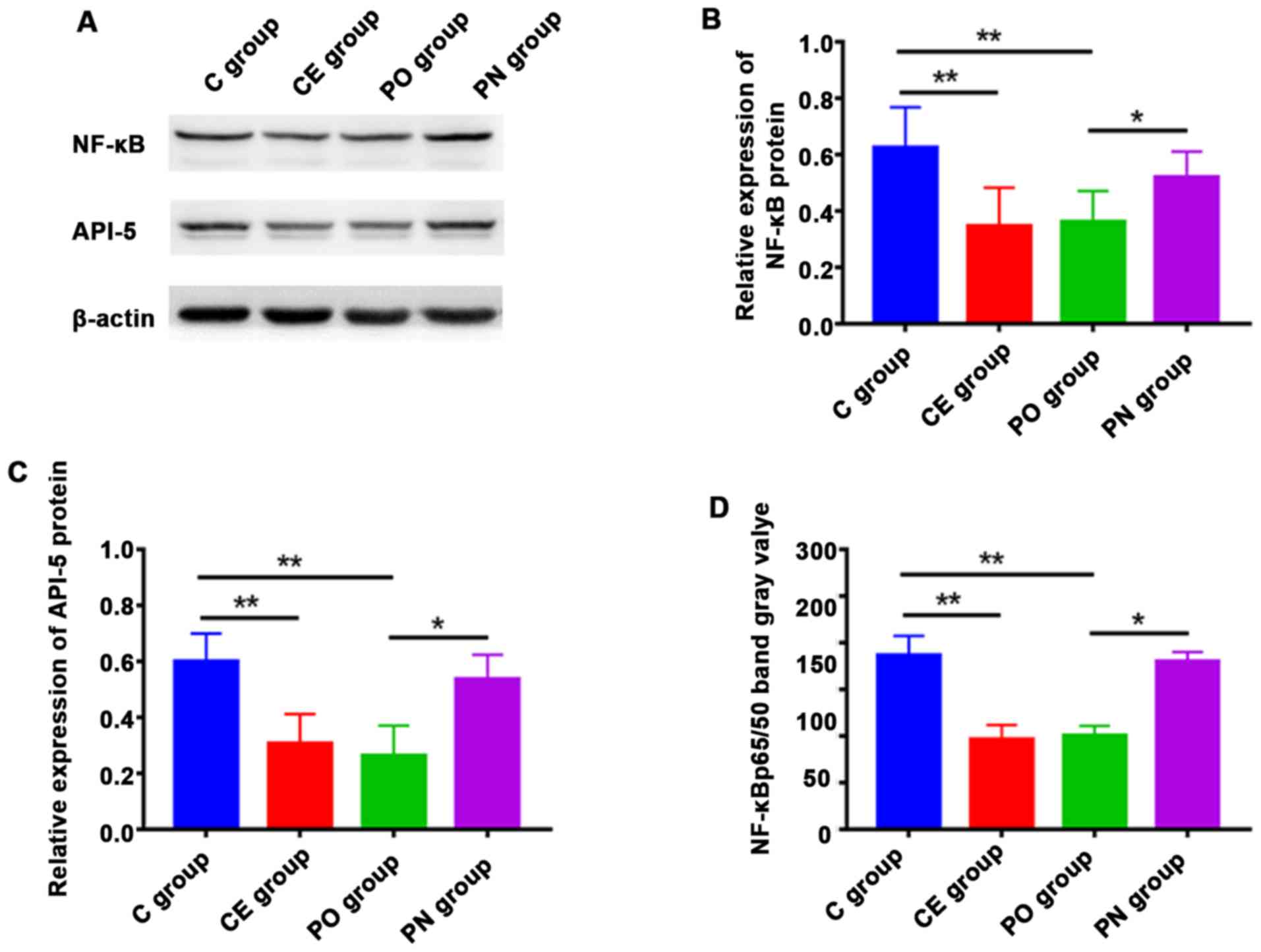Paeonol‑mediated apoptosis of hepatocellular carcinoma cells by NF‑κB pathway
- Authors:
- Published online on: November 19, 2018 https://doi.org/10.3892/ol.2018.9730
- Pages: 1761-1767
-
Copyright: © Li et al. This is an open access article distributed under the terms of Creative Commons Attribution License.
Abstract
Introduction
Hepatocellular carcinoma is one of the common malignant tumors in China with a high mortality rate and incidence rate that is on the increase annually. The common cause of the disease is infection by hepatitis C viruses (1,2). With the continuous development of medical technologies and the deepening of research on the pathogenesis and treatment of hepatocellular carcinoma, the current treatments for patients with hepatocellular carcinoma include radiotherapy, chemotherapy, and surgical resection. Most patients have progressed into the advanced stage at the time of diagnosis and missed the optimal time to receive medical treatment. Consequently, medical chemotherapy becomes the main treatment method, which is of great significance for improving the quality of life of patients and extending their survival time (3–6).
At present, either the effect of monotherapy or that of combined administration for treating the patients with hepatocellular carcinoma is poor, and the chemotherapy has many side effects; thus, identification of a therapeutic drug with good curative effects and few side effects is essential (7). Paeonol, also known as peony phenol, is the main active ingredient of peony root barks and Paniculate swallowwort root or the whole herb, which has multiple pharmacological functions such as immune regulation and cardiovascular and cerebrovascular protection (8). Previous findings based on in vitro experiments have shown that paeonol can kill a variety of malignant tumor cells. Thus, paeonol may be developed into a potential treatment for malignant tumors (9). Yang et al (10) found that paeonol can effectively promote the effect of Platinum on the treatment of hepatocellular carcinoma and reduce the additive dosage of cisplatin. The direct pharmacological effect of paeonol on hepatocellular carcinoma has not been studied, and its mechanism of killing cancer cells is still not clear. It has been found that hepatocellular carcinoma apoptosis inhibitor-5 (API-5) is closely related to apoptosis. Nuclear factor-κ-light-chain-enhancer of activated B cells (NF-κB), as the upstream gene of paeonol, can influence the phosphorylation of API-5 by activating NF-κB signaling pathways, thus playing physiological roles (11).
In this study, the effects of paeonol on the proliferation and apoptosis of human hepatoma (Huh7) cells were investigated by in vitro experiments, and the effects of paeonol on the expressions of API-5 and NF-B were observed, in order to determine the effects of paeonol on hepatocellular carcinoma cells and reveal its underlying mechanism, thus providing new ideas and new methods for the clinical treatment of hepatocellular carcinoma.
Materials and methods
Materials and instruments
Human hepatoma Huh7 cell line (Kunming Cell Bank, Chinese Academy of Sciences); Dulbecco's modified Eagle medium (DMEM) (Grand Island Biological Company (GIBCO), Grand Island, NY, USA), 3-(4,5-dimethylthiazol-2-yl)-2,5-diphenyltetrazolium bromide (MTT) (Sigma-Aldrich; Merck KGaA, Darmstadt, Germany); paeonol and cisplatin (Shanghai Aladdin Biochemical Technology Co., Ltd.); tumor necrosis factor-α (TNF-α) and dimethyl sulfoxide (DMSO) (Sigma-Aldrich; Merck KGaA); radioimmunoprecipitation assay (RIPA) lysate as well as protease inhibitors and phosphatase inhibitors (Wuhan Google Biotechnology Co., Ltd.); TRIzol kit and reverse transcription kits (Invitrogen; Thermo Fisher Scientific, Inc., Waltham, MA, USA); rabbit anti-human NF-κB, pretein-API-5 (anti-p-API-5), NF-κB p65/50, glyceraldehyde 3-phosphate dehydrogenase (anti-GAPDH) polyclonal antibodies and horseradish peroxidase-labeled goat anti-rabbit secondary polyclonal antibody (cat nos. 14220-1-AP, 25689-1-AP, 15506-1-AP, 10494-1-AP, SA00001-2; ProteinTech Group, Inc.; Wuhan Sanying Biotechnology, Wuhan, China); enhanced chemiluminescence (ECL) solution and developing powder (Invitrogen; Thermo Fisher Scientific, Inc.); Hoechst staining kits (Wuhan Google Biotechnology Co., Ltd); terminal deoxynucleotidyl transferase 2′-deoxyuridine 5′-triphosphate nick end labeling (TUNEL) and flow apoptosis detection kits (Cell Signaling Technology, Inc., Danvers, MA, USA); ultraviolet spectrophotometer (Beckman Coulter, Inc., Brea, CA, USA); electrophoresis apparatus (Corning Incorporated, Corning, NY, USA); and low-temperature centrifugal machine (Thermo Fisher Scientific, Inc.) were used in the present study.
The study was approved by the Ethics Committee of the Second Hospital of Shandong University (Jinan, China).
Effects of paeonol on proliferation of hepatocellular carcinoma cells
After the human hepatoma Huh7 cell line was resuscitated, it was cultured in an incubator containing 5% CO2 at 37°C. After sub-culture, the cells were seeded in 96-well plates. The number of cells inoculated per well was 6×103. At 24 h after inoculation, the serum was deprived for 2 h. Then different concentrations of paeonol (800, 600, 400, 200, 100, 50 and 1 µM) were added, and the blank control and positive drug groups (cisplatin (2 µg/ml)) were established. After drug treatment and incubation for 24 h, 1% MTT was added and the serum was kept in the dark. Cells in the plates were further incubated in the incubator for 4 h and then removed, and the medium was discarded. After 150 µl of DMSO was added to each well, the plates were vibrated for 10 min, and the optical density (OD) value, at the wavelength of 570 nm, was detected using a microplate reader (Bio-Rad, Hercules, CA, USA). The survival rate of the cells was calculated by referring to the OD value of each group/the OD value of the normal control group, with the latter as the standard.
Detection of effects of paeonol on the apoptosis of hepatocellular carcinoma cells by flow cytometry
Huh7 cells under good growth conditions were selected, and cells were added to 6-well plates after the cell density was adjusted to 5×106/ml. The cells were divided into the blank control group (C group), parthenolide group [CE group (5 µmol/l)], paeonol group [PO group (500 µM)] and paeonol (600 µM) + TNF-α (104 U/l) group (PN group), in which parthenolide was an inhibitor of NF-κB and TNF-α was an activator of NF-κB. After the treatment for 24 h, the cells were washed twice with pre-cooled phosphate-buffered saline (PBS) and centrifuged at 1,500 × g for 10 min at 4°C after washing. The apoptotic cell suspension was prepared and operated in accordance with the instructions of apoptosis detection kits. The cells were resuspended and centrifuged at 3,000 × g for 8 min at 4°C. Then the cells were added with the fluorescence solution (Thermo Fisher Scientific, Inc.) and incubated at room temperature in the dark for 15 min. After that, the detection by flow cytometry was conducted.
Detection of effects of paeonol on the apoptosis of hepatocellular carcinoma cells by Hoechst staining
Huh7 cells under good growth conditions were selected, and cells were added to 6-well plates after the cell density was adjusted to 5×106/ml. The cells were divided into the blank control group (C group), parthenolide group (CE group), paeonol group (PO group) and paeonol + TNF-α group (PN group). Concentrations of drugs were set the same as above. After treatment for 24 h, culture medium was removed, and then 4% paraformaldehyde was added for the fixation for 5 min. The cells were washed twice with PBS, 200 µl staining solution A prepared in a Hoechst-33258 kit was added for the incubation for 15 min in the dark, and then the washing solution B was added and the cells were washed twice. Cells were observed under a fluorescence microscope (Olympus, Tokyo, Japan), which showed that the wavelength was 352 nm.
Detection of the expression levels of relevant mRNAs by quantitative polymerase chain reaction (qPCR)
The RNA of treated Huh7 cells in all the above groups were extracted using TRIzol kits. The RNA integrity was confirmed by 2% agarose gel electrophoresis, the results of which showed that the 28S, 18S and 5S bands were clear and the brightness of the band 28S was ~2-fold brighter than that of 18S, indicating that the RNA was intact and could be used for subsequent experiments. The OD value of RNA in each group was detected, and it was found that the A260/A280 of each group was between 1.8 and 2.0, which indicated that the extracted RNA had better quality. cDNA was obtained from the reverse transcription using reverse transcription kits. The expression levels of NF-κB and API-5 were detected by semi-quantitative PCR (Sigma-Aldrich; Merck KGaA) with GAPDH as the internal reference. Reaction conditions were: Pre-denaturation at 95°C for 5 min, at 95°C for 30 sec, at 64°C for 25 sec and at 72°C for 30 sec, and the process was repeated for 35 cycles, followed by extension at 72°C for 7 min. Primers were produced by TianGen BioTech (Beijing) Co., Ltd. (Table I). Subsequently, 2% agarose gel electrophoresis was applied, and the sequences were observed under an ultraviolet imaging system. The expression levels of NF-κB and API-5 mRNAs were detected by semi-quantification of the band brightness/GAPDH brightness in each group.
Detection of the expression levels of relevant proteins by western blot analysis
Treated Huh7 cells placed in 6-well plates were selected, the culture medium was discarded and 70 µl RIPA lysate containing 1% protease inhibitor and 1% phosphatase inhibitor was added to each well for lysis. After the cells were centrifuged at 3,000 × g at 12°C for 10 min, the supernatant was discarded and 12 µl protein was quantified by bicinchoninic acid (BCA) protein assay kit (Invitrogen; Thermo Fisher Scientific, Inc.). After that, sodium dodecyl sulfate polyacrylamide gel electrophoresis (SDS-PAGE) was conducted using 12% gel. The film was transferred at 100 V for 90 min, and the target protein was transferred to the polyvinylidene difluoride (PVDF) membrane and blocked for 2 h. Then the target bands were cut and incubated overnight at 4°C with NF-κB, p-API-5 andNF-κB p65/50 primary antibodies (1:1,000). Then the bands were washed with Tris-buffered saline with Tween-20 (TBST) three times, and 5 min after each washing, secondary antibodies (1:5,000) were incubated at room temperature for 2 h. After the washing with TBST for an additional three times, an appropriate amount of ECL solutions were added in the dark (uniform mixture of A and B solution at a ratio of 1:1), and tablet pressing was performed. According to the fluorescence intensity of protein bands, the time of tablet pressing was determined. The fixation was performed after development, and after the bands were scanned, the gray value was analyzed using ImageJ version 1.36b software (NIH, Bethesda, MD, USA).
Statistical analysis
Data in this study were expressed as mean ± standard deviation and analyzed by Statistical Product and Service Solutions (SPSS) 19.0 software (SPSS Inc., Chicago, IL, USA). The t-test was used for comparisons between two groups, while the analysis of variance was used for comparisons among multiple groups. If the variance was homogeneous, the Bonferroni correction was used for pairwise comparisons, but if the variance was heterogeneous, the Welch's method was used for pairwise comparisons and Dunnett's T3 method for comparisons among multiple groups. P<0.05 indicated there were no statistically significant differences.
Results
Detection of paeonol on the viability of hepatocellular carcinoma cells by MTT assay
The effects of paeonol at different concentration gradients on the viability of Huh7 cells were detected by MTT assay. As shown in Fig. 1, following treatment of Huh7 cells with 200–800 µM paeonol, the viability of Huh7 cells was significantly inhibited compared with that in the blank control group (P<0.01), indicating that based on concentrations paeonol can effectively inhibit the proliferation of Huh7 cells. Compared with the control group, the viability of Huh7 cells treated with 200 and 400 µM paeonol was significantly decreased (P<0.05). After treatment with 600 and 800 µM, the cell viability decreased more significantly, and the effect intensity was dose-dependent (P<0.01). When the concentration of paeonol was 563 µM, the viability of Huh7 cells was only 50% of that of the control group (data not shown).
Detection of paeonol on the apoptosis of Huh7 cells by flow cytometry
The effect of paeonol on the apoptosis of Huh7 cells was detected by flow cytometry. Following treatment with 563 µM paeonol, the apoptotic levels of cells in the PO and CE groups were significantly increased compared with that in the C group, and those in the PO group and CE group were higher than that in the PN group (Fig. 2). The differences were statistically significant (P<0.01).
Detection of paeonol on the apoptosis of hepatocellular carcinoma cells by Hoechst staining
The effect of paeonol on the apoptosis of human Huh7 cells was detected by Hoechst-33258 staining. As shown in Fig. 3, the apoptotic levels of cells in the CE and PO groups were significantly higher than that in the C group following treatment with 563 µM paeonol (P<0.01), and those in the PO group were significantly increased compared with that in the PN group (P<0.05).
Detection of the expression level of mRNA by semi-quantitative PCR
The expression levels of NF-κB and API-5 mRNAs were detected by semi-quantitative PCR. The expression levels of NF-κB and API-5 in the CE and PO groups were significantly decreased compared with those in the C group (P<0.01), and those in the PO group were lower than those in the PN group (P<0.05) (Fig. 4).
Detection of the expression levels of proteins via western blot analysis
Western blot analysis was used to detect the expression levels of NF-κB and p-API-5 proteins. The expression levels of NF-κB and p-API-5 in the CE and PO groups were significantly lower those in the C group, and those in the PO group were lower than those in the PN group. The differences were statistically significant (P<0.01) (Fig. 5). The expression level of NF-κB p65/50 in each group was detected. The results indicated that the expression levels of NF-κB p65/50 in the CE and PO groups were significantly lower than that in the C group (P<0.05), and those in the CE and PO groups were significantly lower than that in the PN group. The differences were statistically significant (P<0.01).
Discussion
Early-onset hepatocellular carcinoma often lacks typical clinical symptoms. Except for early investigation, many patients have progressed into the middle or advanced stage at the time of diagnosis. The treatment for advanced hepatocellular carcinoma often lacks surgical conditions, and chemotherapy and radiotherapy are generally applied. At present, chemotherapeutics for hepatocellular carcinoma have many side effects with poor curative effects and other shortcomings (12). Previous findings have shown that paeonol has many significant pharmacological effects such as preventing and treating cancer, promoting cancer cell apoptosis and inhibiting cancer cell proliferation and migration (13). Longo et al (14) found that the expression level of breast cancer tissue NF-κB is significantly increased, and inhibiting NF-κB signaling pathway can effectively increase cell apoptosis. In addition, API-5 participates in inhibiting the apoptosis of hepatocellular carcinoma cells, promotes the proliferation and migration of hepatocarcinoma cells, and cooperates with other oncogenes to regulate the occurrence and development of hepatocellular carcinoma (15,16). The pharmacological effects of paeonol on hepatocarcinoma cells and its mechanism remain to be determined, and whether API-5 and NF-B signaling pathways are involved in the above process is still unclear.
In this study, the effect of paeonol on the proliferation of Huh7 cells was studied by in vitro experiments, and its possible mechanism was discussed. The results showed that paeonol inhibited the proliferation of Huh7 cells, and its effect intensity was dose-dependent. With the increase of paeonol concentration, the inhibitory effect of paeonol on the proliferation of Huh7 cells was stronger, and 200–800 µM paeonol inhibited Huh7 cell proliferation. A large number of studies have shown that paeonol plays a role in promoting apoptosis in a variety of tumor cells (17,18). In this study, parthenolide and TNF-α were used as controls, and TNF-α was an activator of NF-κB while parthenolide was an inhibitor of NF-κB. The effect of NF-κB signaling pathway in paeonol promoting the apoptosis of hepatocellular carcinoma cells was studied using flow cytometry and Hoechst-33258 staining. The results showed that the apoptotic levels of cells in the CE and PO groups were significantly increased compared with that in the C group, and those in the CE and PO groups were significantly higher than that in the PN group. The differences were statistically significant (P<0.01). The above results indicated that NF-κB was involved in the promotion of paeonol on the apoptosis of hepatocellular carcinoma cells. Inhibiting NF-κB could effectively increase the apoptosis of hepatocellular carcinoma cells and inhibit the proliferation of hepatocellular carcinoma cells. NF-κB signaling pathway and the expression of its downstream proteins were studied using semi-quantitative PCR and western blot analysis. The results showed that the expression levels of NF-κB, p-API-5 and NF-κB p65/50 in the PO group were significantly lower than those in the C group, indicating that paeonol can inhibit the expression and activation of NF-κB. The expression level of p-API-5 can be affected by regulating NF-κB through its inhibitors and activators, suggesting that API-5 may be the downstream gene of NF-κB signaling pathway. Paeonol inhibits NF-κB expression to decrease the level of p-API-5, thus regulating the apoptosis of hepatocellular carcinoma cells. NF-κB is transformed from p50 homodimer to p60/p50 heterodimer with transcriptional activity. The activated NF-κB is transferred from the cytoplasm to the nucleus for transcription. It can transcribe a series of oncogenes related to cell growth and promote the production of tumors, so the activation condition of the NF-κB signaling pathway can be evaluated by NF-κB p65/50 (19,20). However, there are some shortcomings in this experiment. Besides the NF-κB signaling pathway, whether there are other ways of affecting the apoptosis of hepatocellular carcinoma cells needs to be determined. In addition, the effect of paeonol at the effective concentration on healthy liver cells is not clear. These issues are to be the focus of further studies. In conclusion, it has been verified from many perspectives in this study that paeonol can inhibit the NF-κB signaling pathway, reducing the expression level of API-5 and further promoting the apoptosis of hepatocellular carcinoma cells by inhibiting the expression of NF-κB. Therefore, there is great potential for paeonol being developed into a drug for treating hepatocellular carcinoma.
Acknowledgements
Not applicable.
Funding
No funding was received.
Availability of data and materials
The datasets used and/or analyzed during the present study are available from the corresponding author on reasonable request.
Authors' contributions
QL drafted this manuscript. QL and YZ carried out the MTT assay. QL and JS were instrumental in performing flow cytometry. QL and QB were responsible for the PCR and western blot analysis. All authors read and approved the final manuscript.
Ethics approval and consent to participate
The study was approved by the Ethics Committee of the Second Hospital of Shandong University (Jinan, China).
Patient consent for publication
Not applicable.
Competing interests
The authors declare that they have no competing interests.
References
|
Korean Liver Cancer Study Group (KLCSG); National Cancer Center, Korea (NCC), . 2014 Korean Liver Cancer Study Group-National Cancer Center Korea practice guideline for the management of hepatocellular carcinoma. Korean J Radiol. 16:465–522. 2015. View Article : Google Scholar : PubMed/NCBI | |
|
Sun Z, Chen T, Thorgeirsson SS, Zhan Q, Chen J, Park JH, Lu P, Hsia CC, Wang N, Xu L, et al: Dramatic reduction of liver cancer incidence in young adults: 28 year follow-up of etiological interventions in an endemic area of China. Carcinogenesis. 34:1800–1805. 2013. View Article : Google Scholar : PubMed/NCBI | |
|
Berretta M, Stanzione B, Di Francia R and Tirelli U: The expression of PD-L1 APE1 and P53 in hepatocellular carcinoma and its relationship to clinical pathology. Eur Rev Med Pharmacol Sci. 19:4207–4209. 2015.PubMed/NCBI | |
|
Chang ET, Yang J, Alfaro-Velcamp T, So SK, Glaser SL and Gomez SL: Disparities in liver cancer incidence by nativity, acculturation, and socioeconomic status in California Hispanics and Asians. Cancer Epidemiol Biomarkers Prev. 19:3106–3118. 2010. View Article : Google Scholar : PubMed/NCBI | |
|
Moris D, Vernadakis S, Papalampros A, Petrou A, Dimitroulis D, Spartalis E, Felekouras E and Fung JJ: The effect of Guidelines in surgical decision making: The paradigm of hepatocellular carcinoma. J BUON. 21:1332–1336. 2016.PubMed/NCBI | |
|
Barbier-Torres L, Delgado TC, García-Rodríguez JL, Zubiete-Franco I, Fernández-Ramos D, Buqué X, Cano A, Gutiérrez-de Juan V, Fernández-Domínguez I, et al: Stabilization of LKB1 and Akt by neddylation regulates energy metabolism in liver cancer. Oncotarget. 6:2509–2523. 2015. View Article : Google Scholar : PubMed/NCBI | |
|
Yang Y, Wu QJ, Xie L, Chow WH, Rothman N, Li HL, Gao YT, Zheng W, Shu XO and Xiang YB: Prospective cohort studies of association between family history of liver cancer and risk of liver cancer. Int J Cancer. 135:1605–1614. 2014. View Article : Google Scholar : PubMed/NCBI | |
|
Li SS, Li GF, Liu L, Jiang X, Zhang B, Liu ZG, Li XL, Weng LD, Zuo T and Liu Q: Evaluation of paeonol skin-target delivery from its microsponge formulation: In vitro skin permeation and in vivo microdialysis. PLoS One. 8:e798812013. View Article : Google Scholar : PubMed/NCBI | |
|
Ye JM, Deng T and Zhang JB: Influence of paeonol on expression of COX-2 and p27 in HT-29 cells. World J Gastroenterol. 15:4410–4414. 2009. View Article : Google Scholar : PubMed/NCBI | |
|
Yang Q, Wang S, Xie Y, Wang J, Li H, Zhou X and Liu W: Effect of salvianolic acid B and paeonol on blood lipid metabolism and hemorrheology in myocardial ischemia rabbits induced by pituitruin. Int J Mol Sci. 11:3696–3704. 2010. View Article : Google Scholar : PubMed/NCBI | |
|
Koci L, Chlebova K, Hyzdalova M, Hofmanova J, Jira M, Kysela P, Kozubik A, Kala Z and Krejci P: Apoptosis inhibitor 5 (API-5; AAC-11; FIF) is upregulated in human carcinomas in vivo. Oncol Lett. 3:913–916. 2012.PubMed/NCBI | |
|
Chen X and Calvisi DF: Hydrodynamic transfection for generation of novel mouse models for liver cancer research. Am J Pathol. 184:912–923. 2014. View Article : Google Scholar : PubMed/NCBI | |
|
Horng CT, Shieh PC, Tan TW, Yang WH and Tang CH: Paeonol suppresses chondrosarcoma metastasis through up-regulation of miR-141 by modulating PKCδ and c-Src signaling pathway. Int J Mol Sci. 15:11760–11772. 2014. View Article : Google Scholar : PubMed/NCBI | |
|
Longo DM, Selimkhanov J, Kearns JD, Hasty J, Hoffmann A and Tsimring LS: Dual delayed feedback provides sensitivity and robustness to the NF-κB signaling module. PLoS Comput Biol. 9:e10031122013. View Article : Google Scholar : PubMed/NCBI | |
|
Pekow J, Meckel K, Dougherty U, Butun F, Mustafi R, Lim J, Crofton C, Chen X, Joseph L and Bissonnette M: Tumor suppressors miR-143 and miR-145 and predicted target proteins API5, ERK5, K-RAS, and IRS-1 are differentially expressed in proximal and distal colon. Am J Physiol Gastrointest Liver Physiol. 308:G179–G187. 2015. View Article : Google Scholar : PubMed/NCBI | |
|
Baxter PA, Lin Q, Mao H, Kogiso M, Zhao X, Liu Z, Huang Y, Voicu H, Gurusiddappa S, Su JM, et al: Silencing BMI1 eliminates tumor formation of pediatric glioma CD133+ cells not by affecting known targets but by down-regulating a novel set of core genes. Acta Neuropathol Commun. 2:1602014. View Article : Google Scholar : PubMed/NCBI | |
|
Li H, Xie YH, Yang Q, Wang SW, Zhang BL, Wang JB, Cao W, Bi LL, Sun JY, Miao S, et al: Cardioprotective effect of paeonol and danshensu combination on isoproterenol-induced myocardial injury in rats. PLoS One. 7:e488722012. View Article : Google Scholar : PubMed/NCBI | |
|
Musselman CA and Kutateladze TG: Methyl fingerprinting of the nucleosome reveals the molecular mechanism of high-mobility group nucleosomal-2 (HMGN2) association. Proc Natl Acad Sci USA. 108:12189–12190. 2011. View Article : Google Scholar : PubMed/NCBI | |
|
Hämäläinen M, Nieminen R, Vuorela P, Heinonen M and Moilanen E: Anti-inflammatory effects of flavonoids: Genistein, kaempferol, quercetin, and daidzein inhibit STAT-1 and NF-kappaB activations, whereas flavone, isorhamnetin, naringenin, and pelargonidin inhibit only NF-kappaB activation along with their inhibitory effect on iNOS expression and NO production in activated macrophages. Mediators Inflamm. 2007:456732007. View Article : Google Scholar : PubMed/NCBI | |
|
Szukiewicz D, Wojciechowska M, Bilska A, Stangret A, Szewczyk G, Mittal TK, Watroba M and Kochanowski J: Aspirin action in endothelial cells: Different patterns of response between chemokine CX3CL1/CX3CR1 and TNF-alpha/TNFR1 signaling pathways. Cardiovasc Drugs Ther. 29:219–229. 2015. View Article : Google Scholar : PubMed/NCBI |



